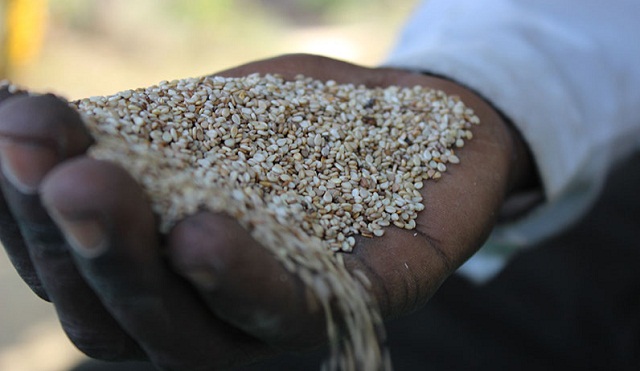
Kampala, Uganda | THE INDEPENDENT | Adverse weather conditions have placed Simsim productions in the Acholi, Lango and West Nile subregions on a steep decline.
The decline in the trend of Simsim production started becoming clear among farmers in 2010 as rainfall patterns shifted by an average of two months under rising temperatures from January to April.
Farmers in the subregions say they can no longer achieve the 700 Kilograms they used to harvest from a hectare of land as droughts become more frequent in the areas.
Lucy Ajok, a Simsim farmer in Apac district says changes in weather conditions is affecting production, processing and marketing of simsim produce among smallholder farmers in the district. She says droughts affect flowering and fruiting of Simsim while too much water affects the quality of Simsim by decolouring its whitish appearance.
Mike Atube, a Simsim farmer from Lamwo district says they have also observed similar trends among farmers in Lamwo. He says farmers are coping up by increasing their land sizes.
The farmers say they have resorted to fast maturing simsim varieties or drought-tolerant varieties they acquire from agro-input dealers to achieve at least 500 Kilograms per hectare of land.
Dr Walter Anyanga, a crop scientist at the National Agriculture Research Organization in Serere Research Center says the decline in Simsim production amongst farmers triggered search for tolerant crop varieties of simsim that can resist drought and too much rainfall.
Dr Anyanga says the first variety was released in 2003 while another was produced in 2013. He says both varieties have unique coping mechanisms for farmers to achieve high yields.
The UN Food and Agriculture Organization say simsim production is projected to decline further over the next ten years as climate change impacts the value chain. It says production will decline from 1.5 tonnes per hectare down to 0.2 tonnes per hectare in the run-up to 2050.
At this time, temperature is expected to rise by three degrees Celsius over 2.8 degrees Celsius over South Western part of Uganda and about 2.5 degrees Celsius over the Central and Northern part while Eastern part will experience a 2 degrees Celsius rise over the short and long rainy seasons.
According to FAO, the temperature rise will frustrate farmers the more as large farmers utilize approximately 20 acres of land. It says in 2010, Uganda was the fifth global producer of Simsim, achieving peak production of 216,000 metric tonnes in 2012.
In 2018, the Netherlands Development Organization SNV commissioned a study to assess the risks of climate change on Simsim in the sub-regions.
Dr Confidence Duku, one of the researchers who participated in the survey says findings indicates that climate change affect the simsim value chain in various ways. He says they found that droughts have become too frequent around the growing seasons of simsim across the sub-regions.
Dr Duku who is attached to Wageningen University in the Netherlands says shortening of the long rainy season falling between March and May and the subsequent rise in temperatures over the short rainy season (October to December) is affecting simsim production.
Simsim is a staple food amongst the Acholi, Lango and in West Nile. It replaced cotton as cash crop due to its resilience to adverse weather conditions such as droughts among these ethnic groups. Any threat to the crop is a direct threat on their livelihoods.
It is projected that Uganda’s economic losses from agriculture sector will reach 1.5 Billion US Dollars by the year 2050 unless farmers adopt Climate-Smart agriculture practices such as the use of irrigation in order to build resilience, improve household income and productivity.
*****
URN
 The Independent Uganda: You get the Truth we Pay the Price
The Independent Uganda: You get the Truth we Pay the Price



